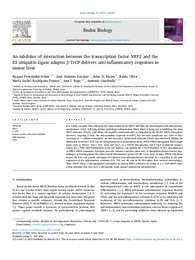Por favor, use este identificador para citar o enlazar este ítem:
https://hdl.handle.net/11000/30651Registro completo de metadatos
| Campo DC | Valor | Lengua/Idioma |
|---|---|---|
| dc.contributor.author | Fernández Ginés, Raquel | - |
| dc.contributor.author | Encinar, José Antonio | - |
| dc.contributor.author | Hayes, John | - |
| dc.contributor.author | Oliva, Baldomero | - |
| dc.contributor.author | Rodríguez-Franco, María Isabel | - |
| dc.contributor.author | Rojo, Ana I | - |
| dc.contributor.author | Cuadrado, Antonio | - |
| dc.contributor.other | Departamentos de la UMH::Bioquímica y Biología Molecular | es_ES |
| dc.date.accessioned | 2024-01-26T08:57:36Z | - |
| dc.date.available | 2024-01-26T08:57:36Z | - |
| dc.date.created | 2022-07-04 | - |
| dc.identifier.citation | Redox Biology, 55 (2022), 102396 | es_ES |
| dc.identifier.issn | 2213-2317 | - |
| dc.identifier.uri | https://hdl.handle.net/11000/30651 | - |
| dc.description.abstract | It is widely accepted that activating the transcription factor NRF2 will blast the physiological anti-inflammatory mechanisms, which will help combat pathologic inflammation. Much effort is being put in inhibiting the main NRF2 repressor, KEAP1, with either electrophilic small molecules or disrupters of the KEAP1/NRF2 interaction. However, targeting β-TrCP, the non-canonical repressor of NRF2, has not been considered yet. After in silico screening of ~1 million compounds, we now describe a novel small molecule, PHAR, that selectively inhibits the interaction between β-TrCP and the phosphodegron in transcription factor NRF2. PHAR upregulates NRF2-target genes such as Hmox1, Nqo1, Gclc, Gclm and Aox1, in a KEAP1-independent, but β-TrCP dependent manner, breaks the β-TrCP/NRF2 interaction in the cell nucleus, and inhibits the β-TrCP-mediated in vitro ubiquitination of NRF2. PHAR attenuates hydrogen peroxide induced oxidative stress and, in lipopolysaccharide-treated macrophages, it downregulates the expression of inflammatory genes Il1b, Il6, Cox2, Nos2. In mice, PHAR selectively targets the liver and greatly attenuates LPS-induced liver inflammation as indicated by a reduction in the gene expression of the inflammatory cytokines Il1b, TNf, and Il6, and in F4/80-stained liver resident macrophages. Thus, PHAR offers a still unexplored alternative to current NRF2 activators by acting as a β-TrCP/NRF2 interaction inhibitor that may have a therapeutic value against undesirable inflammation. | es_ES |
| dc.format | application/pdf | es_ES |
| dc.format.extent | 17 | es_ES |
| dc.language.iso | eng | es_ES |
| dc.publisher | Elsevier | es_ES |
| dc.rights | info:eu-repo/semantics/openAccess | es_ES |
| dc.rights | Attribution-NonCommercial-NoDerivatives 4.0 Internacional | * |
| dc.rights.uri | http://creativecommons.org/licenses/by-nc-nd/4.0/ | * |
| dc.subject | NRF2 | es_ES |
| dc.subject | β-TrCP | es_ES |
| dc.subject | protein-protein interaction inhibitor | es_ES |
| dc.subject | inflammation | es_ES |
| dc.subject | liver | es_ES |
| dc.subject.classification | Bioquímica y Biología Molecular | es_ES |
| dc.subject.other | CDU::5 - Ciencias puras y naturales::57 - Biología::577 - Bioquímica. Biología molecular. Biofísica | es_ES |
| dc.title | An inhibitor of interaction between the transcription factor NRF2 and the E3 ubiquitin ligase adapter β-TrCP delivers anti-inflammatory responses in mouse liver | es_ES |
| dc.type | info:eu-repo/semantics/article | es_ES |
| dc.relation.publisherversion | https://doi.org/10.1016/j.redox.2022.102396 | es_ES |

Ver/Abrir:
10.1016_j.redox.2022.102396 (4).pdf
11,53 MB
Adobe PDF
Compartir:
 La licencia se describe como: Atribución-NonComercial-NoDerivada 4.0 Internacional.
La licencia se describe como: Atribución-NonComercial-NoDerivada 4.0 Internacional.
.png)